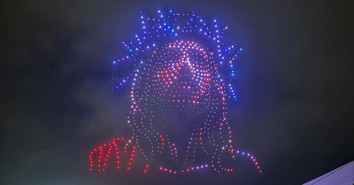Classic Jurassic Park Will Never Go Extinct

Release Date: April 5, 2013
Rating: PG-13 (for intense dinosaur-related terror, and some language)
Genre: Action
Run Time: 127 min
Director: Steven Spielberg
Cast: Sam Neill, Laura Dern, Jeff Goldblum, Richard Attenborough, Samuel L. Jackson, Wayne Knight, Joseph Mazzello, Ariana Richards
The Golden Age of Summer Blockbusters spanned nearly two decades, bookended by films from Steven Spielberg: Jaws in 1975 and Jurassic Park in 1993. Another two decades later, the latter returns to the multiplex.
While a 3D-conversion money grab is the excuse, that overrated technology is not the reason to visit the theater, the movie itself is. Jurassic Park is deservedly a classic, and it deserves to be seen on a big screen – especially since the theatrical experience (IMAX in particular) is better than it’s ever been before. Consequently, so is the movie.
And yet what ultimately elevates Jurassic Park (based on the brainy bestseller by Michael Crichton) to something that endures regardless of screen size or decibel level is the craftsmanship of Spielberg himself. The films that hold up well into new eras are the ones rooted in timeless cinematic sensibilities. Not only is Spielberg’s approach to film language iconic – the phrase "Spielbergian" gets thrown around about as much as Hitchcockian or Kubrickian – but his instincts as to what a movie needs in order to resonate with audiences is legendary. In the case of Jurassic Park, it was understanding that he needed to not only capture the horror of dinosaurs but also their majesty.
For as much as Jurassic Park thrives on monster-movie thrills, it’s also inspired by the grandeur of these resurrected creatures. Some of the thrills are visceral while others elicit slack-jawed awe, even humility. Spielberg meters out these opposite impulses in well-balanced, precisely-paced doses, shifting back and forth between terror and wonder while always bridging the two with a steady build of suspense.
On occasion he’ll meld them, letting terror inspire wonder (dropping live cattle into the raptor feeding pen, for example, or the finale’s Rex ex Machina). Or, as these initially gleeful scientists begin to contemplate not only what’s been achieved on the island but also unleashed upon the earth, just the opposite will occur: wonder inspires terror.
Their philosophical exchanges remain relevant today, even sobering. As advances in genetic engineering, cloning, artificial intelligence, and nanotechnology accelerate, Ian Malcolm’s words resonate now more than ever: "Your scientists were so preoccupied with whether they could that they didn’t stop to think if they should."
Along with those ethical debates, Jurassic Park’s visual effects were also ahead of their time. This dino-thriller about sci-fi evolution run amok also represents cinematic evolution at the moment of its most dramatic leap. A few films had previously employed computer-generated effects, but none had done so to such a life-like degree and on such a grand scale. Pre-Jurassic Park, if you said "dinosaur" to someone it was likely Barney that leapt to mind. To say things changed is an understatement.
What had previously been possible only through the stuttering style of stop-motion now existed smoothly and vividly with actors, and in a world we recognized. We'd literally seen nothing like it before. Jurassic Park set a new standard and, perhaps most amazing of all, it still meets our standards twenty years on. Young people seeing this for the first time will not be disappointed, and may even be in for a few surprises.
There is a precision and detail to these dinosaurs – both in look and motion – that achieves an authenticity many contemporary films still struggle to match. Visual Effects have continued to evolve, but rarely (if ever) have the artists been better than they were when Dennis Muren, Stan Winston, Phil Tippett and Michael Lantieri collaborated for this groundbreaking endeavor. It helps, too, that shots are framed and moved practically rather than in the physics-defying swoops of today’s computer-manipulated post-production visuals.
Spielberg marshals all of these factors – story, style, technology, philosophy (with a big assist from John Williams’ classic score) – to such an effective and satisfying degree that it has made Jurassic Park a quintessential Summer Movie. It’s the kind of blockbuster we go to the theater hoping to see, psyched to experience, and with the power to bring us back for more. It is seared into our collective consciousness, part of our cultural language, and something we want to share and pass on.
For me personally, the whole "journey to the island" sequence – from the helicopter’s flight toward Isla Nublar to the first dinosaur sighting – has become an indelible slice of cinematic comfort food. It’s so perfectly constructed, transporting us away from our world and into its own, all with a sense of fun, magic, and giddy anticipation. It never fails to put a goofy smile on my face as I shovel popcorn into it. It makes me feel like a kid again.
A couple of things certainly jump out as dated (CD-ROMs and UNIX systems, anyone?), but that just adds to the charm. So do the actors, layering both wry humor and genuine emotion into their specifically-contrived yet still well-written roles. As Ian Malcolm, Jeff Goldblum remains a particular favorite, especially with his irresistible use of Chaos Theory as a flirting technique.
It’s rare to have a sure thing just waiting for us at movie theaters, and rarer still to re-experience a Pop Culture classic in a way we never have before. The release of this remastered and suped-up version of Jurassic Park gives us both. I know it’s only spring, but I can't imagine having a better time at the movies all summer.
CAUTIONS:
- Drugs/Alcohol Content: Champagne is served at a meal. One character chain-smokes.
- Language/Profanity: Two h-words, two d-words, two s-words, one "SOB,", one use of the Lord’s name in vain.
- Sexual Content/Nudity: An image of a woman in a bikini is seen on a computer screen.
- Violence: A raptor attack in opening scene (terrifying, but not bloody or graphic). Bloody goat limb on a window. A man eaten by a T-Rex. An extended scene of a T-Rex attack on SUV in which kids are trapped. Man attacked by a dilophosaurus. Terror of a car falling through a tree toward people. A T-Rex chases people in a jeep. A T-Rex attacks and eats other dinosaurs in a few different scenes. Several raptor attacks and chases throughout the final act, including two raptors pursuing kids and trapping them in a kitchen. A man’s bloody severed arm is dropped on someone. A boy is electrocuted and becomes unconscious. Several sequences of dino-related terror, especially in the film’s second half.
Publication date: April 5, 2013
Originally published April 05, 2013.







